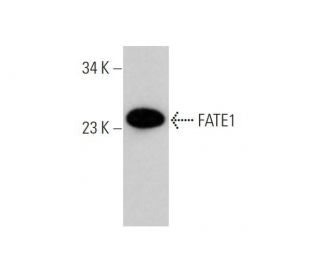


FATE1 Antikörper (B5-9): sc-101220
- FATE1 Antikörper B5-9 ist ein Maus monoklonales IgG1 κ FATE1 Antikörper, verwendet in 1 wissenschaftlichen Veröffentlichungen, in einer Menge von 50 µg/0.5 ml
- gezogen gegen rekombinantes FATE1 aus der Spezies human
- Empfohlen für die Detektion von FATE1 aus der Spezies human per WB, IP, IF, IHC(P) und ELISA
- Aktuell testen wir noch unsere Sekundärantikörper um das beste Bindeprotein für diesen Primärantikörper FATE1 (B5-9) zu finden. Kontaktieren Sie uns bitte, wenn Sie Fragen hierzu haben sollten.
Direktverknüpfungen
Siehe auch...
FATE1-Antikörper (B5-9) ist ein monoklonaler Maus IgG1 κ FATE1-Antikörper (auch als FATE1-Antikörper bezeichnet), der das FATE1-Protein menschlichen Ursprungs mittels WB, IP, IF, IHC (P) und ELISA nachweist. FATE1-Antikörper (B5-9) ist als nicht konjugierter Anti-FATE1-Antikörper erhältlich. FATE1 (fetal und adult testis expressed 1), auch bekannt als FATE, CT43 (Krebs/Testis-Antigen 43) oder BJ-HCC-2, ist ein Krebs/Testis-Antigen, das in Testis und Tumorgewebe (insbesondere in Hepatozellkarzinomzellen) nachgewiesen wird. Seine Expression wird durch SF-1 (Steroidogenes Faktor 1) und WT1 (Wilms-Tumorprotein) reguliert, zwei Proteine, die an der Tumorigenese beteiligt sind, was auf eine Rolle von FATE1 bei der Tumorentwicklung hinweist. FATE1 wird ausschließlich im Testis des 6-11 Wochen alten Fötus (etwa im Zeitraum der gonadalen Geschlechtsdifferenzierung) exprimiert. Mit 7 Wochen wird FATE1 zusammen mit SRY exprimiert und kann eine Rolle bei der frühen testikulären Differenzierung spielen. Bei Erwachsenen wird FATE1 zwar hauptsächlich im Testis exprimiert, kann aber auch in Herz, Niere, Gehirn, Lunge und Nebenniere nachgewiesen werden. Mutationen des Gens, das FATE1 codiert, können Faktoren für die männliche Unfruchtbarkeit sein.
Alexa Fluor® ist ein Markenzeichen von Molecular Probes Inc., OR., USA
LI-COR® und Odyssey® sind Markenzeichen von LI-COR Biosciences
FATE1 Antikörper (B5-9) Literaturhinweise:
- Das menschliche FATE ist ein neues X-chromosomales Gen, das in fötalen und erwachsenen Hoden exprimiert wird. | Olesen, C., et al. 2001. Mol Cell Endocrinol. 184: 25-32. PMID: 11694338
- Mutationsanalyse des menschlichen FATE-Gens bei 144 unfruchtbaren Männern. | Olesen, C., et al. 2003. Hum Genet. 113: 195-201. PMID: 12811541
- Identifizierung zweier neuer CT-Antigene und ihrer Fähigkeit, bei Patienten mit hepatozellulärem Karzinom eine Antikörperreaktion auszulösen. | Dong, XY., et al. 2003. Br J Cancer. 89: 291-7. PMID: 12865919
- Reinigung und Rückfaltung eines neuartigen Krebs/Hoden-Antigens BJ-HCC-2, das in den Einschlusskörpern von Escherichia coli exprimiert wird. | Yang, XA., et al. 2004. Protein Expr Purif. 33: 332-8. PMID: 14711522
- Immunhistochemische Analyse der Expression des FATE/BJ-HCC-2-Antigens in normalen und bösartigen Geweben. | Yang, XA., et al. 2005. Lab Invest. 85: 205-13. PMID: 15580283
- Erhöhte Dosis des steroidogenen Faktors 1 löst die Proliferation von Nebennierenrindenzellen und Krebs aus. | Doghman, M., et al. 2007. Mol Endocrinol. 21: 2968-87. PMID: 17761949
Bestellinformation
| Produkt | Katalog # | EINHEIT | Preis | ANZAHL | Favoriten | |
FATE1 Antikörper (B5-9) | sc-101220 | 50 µg/0.5 ml | $333.00 |
